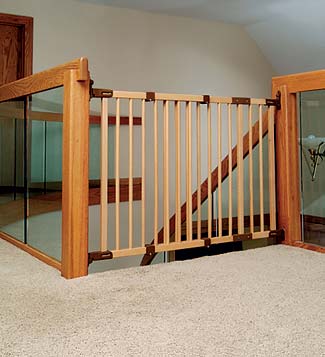You can childproof your log home without compromising style. Here’s how.
by: Carrie Nathans | Log Home Living
Long weekends at grandma’s country cabin are the stuff of fond memories. Knowing your home is safe enough to withstand the wiliest of four-year-old makes these times even sweeter. Contrary to popular belief, a childproof home doesn’t have to resemble a daycare center. Clear outlet protectors, neutral doorstops and removable cabinet locks all blend into existing decor while safeguarding kids and providing what every family needs to enjoy a rustic retreat—peace of mind.
 Childproof Gates:
Childproof Gates:A wrought iron spiral staircase may be the centerpiece of your foyer, but it’s also a treacherous area for toddlers. Solid wood, plastic, metal—even retractable mesh—safety gates come equipped with wall screws to block the top of stairs, allowing no child to pass.
Forgo the toolbox with less permanent options that use paint-friendly, non-skid mounting pads and expand to fit openings at the bottom of stairways. “Look for gates that children cannot dislodge easily, but that adults can open and close without difficulty,” advises Nick Gromicko, founder of the International Association of Certified Home Inspectors.
Childproofing Doors:
Adults and children behold a closed door in very different ways. Whereas grownups receive the “Do Not Enter” message loud and clear, kids are intrigued. Make the closed-door policy more effective with doorknob covers and locks to restrict off-limits areas like sheds, garages and swimming pools. Knob covers have a dual-purpose design: Grip tabs allow adults to grab and turn the knob; when clutched by little hands, the cover spins, preventing a firm grasp.
Childproofing with Latches and Locks:
Out of sight does not necessarily mean out of reach, and little arms can stretch about as far as the imagination when it comes to raiding cabinets, closets and drawers. Lock up chemicals, medications and other dangerous substances with tug-proof safety latches. Adhesive, magnet, and sliding locks require no assembly and protect delicate surfaces and glass.
Removing Sharp Edges:
Tearing down the hallway at Mach speed will tire out tiny troops faster than an afternoon at Gymboree, but rooms with sharp-edged tables and top-heavy furniture are a surefire recipe for injury, especially in tight spaces. Corner bumpers are plastic guards that soften the rough edges of wooden chests and consoles, angular countertops and hearths. Avoiding collisions isn’t always possible, but if and when they do occur, bumpers can mean the difference between a band-aid and a doctor’s bill.
Childproofing Windows:
Families love to congregate on verandas, porches and decks to savor the best views. Inviting as they may be, balconies can be hazardous for little ones, who seem to run, leap and climb at the first whiff of fresh air. Second-story porches should be secured with window guards and safety netting. “Check these safety devices frequently to make sure they are secure and properly installed and maintained,” advises Nick. “There should be no more than 4 inches between the bars of the window guard.”
Covering Outlets:
Uncovered wall outlets are difficult for pint-size paws to resist. Prevent electrocution with sleek outlet covers, plugs and plates available in white, beige and brushed metal. Full coverage plates automatically cover an outlet when a plug is removed to protect prying fingers. Replace any frayed or exposed electrical wires, and tuck long, loose cords behind furniture and beneath rugs.











